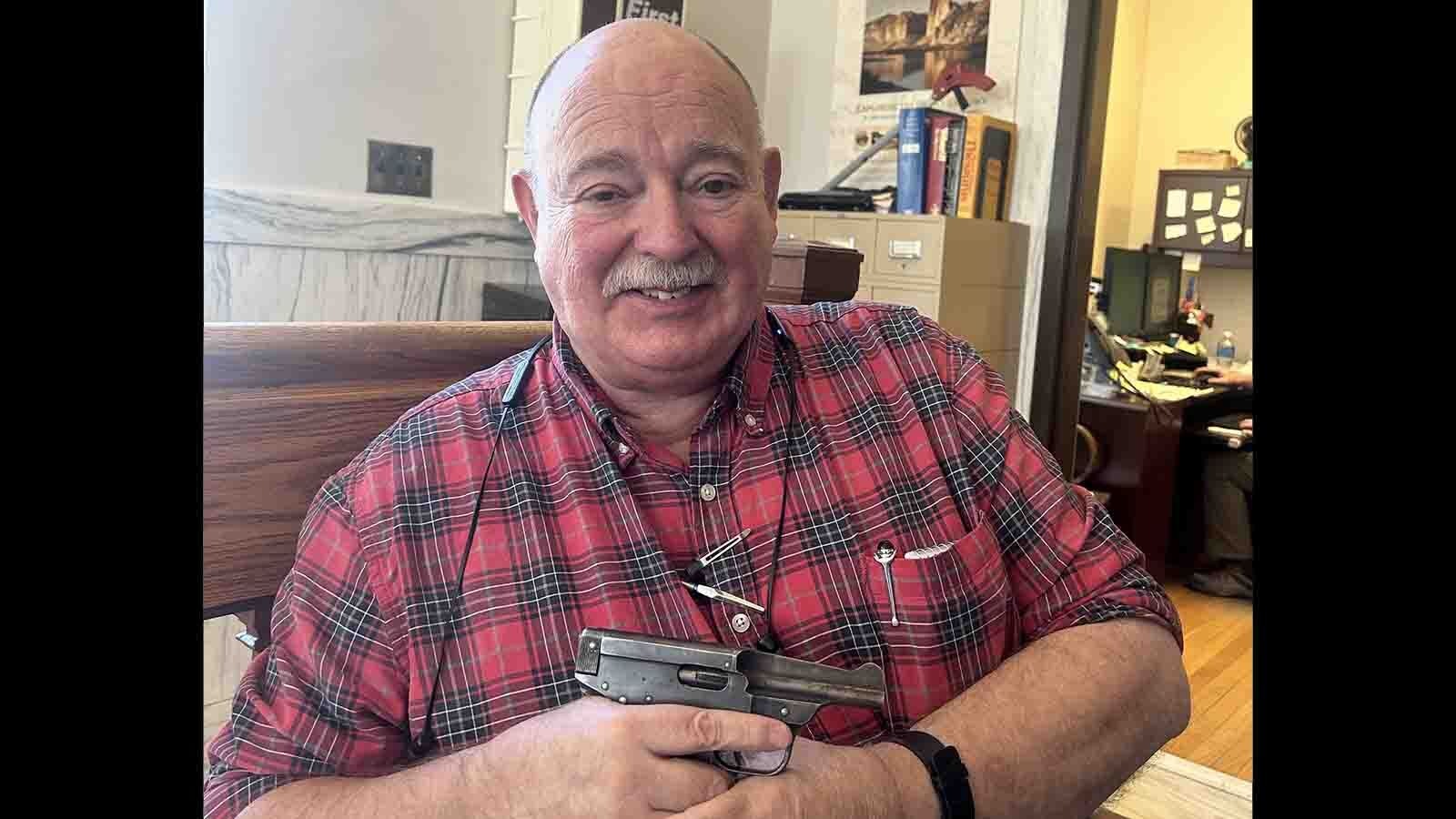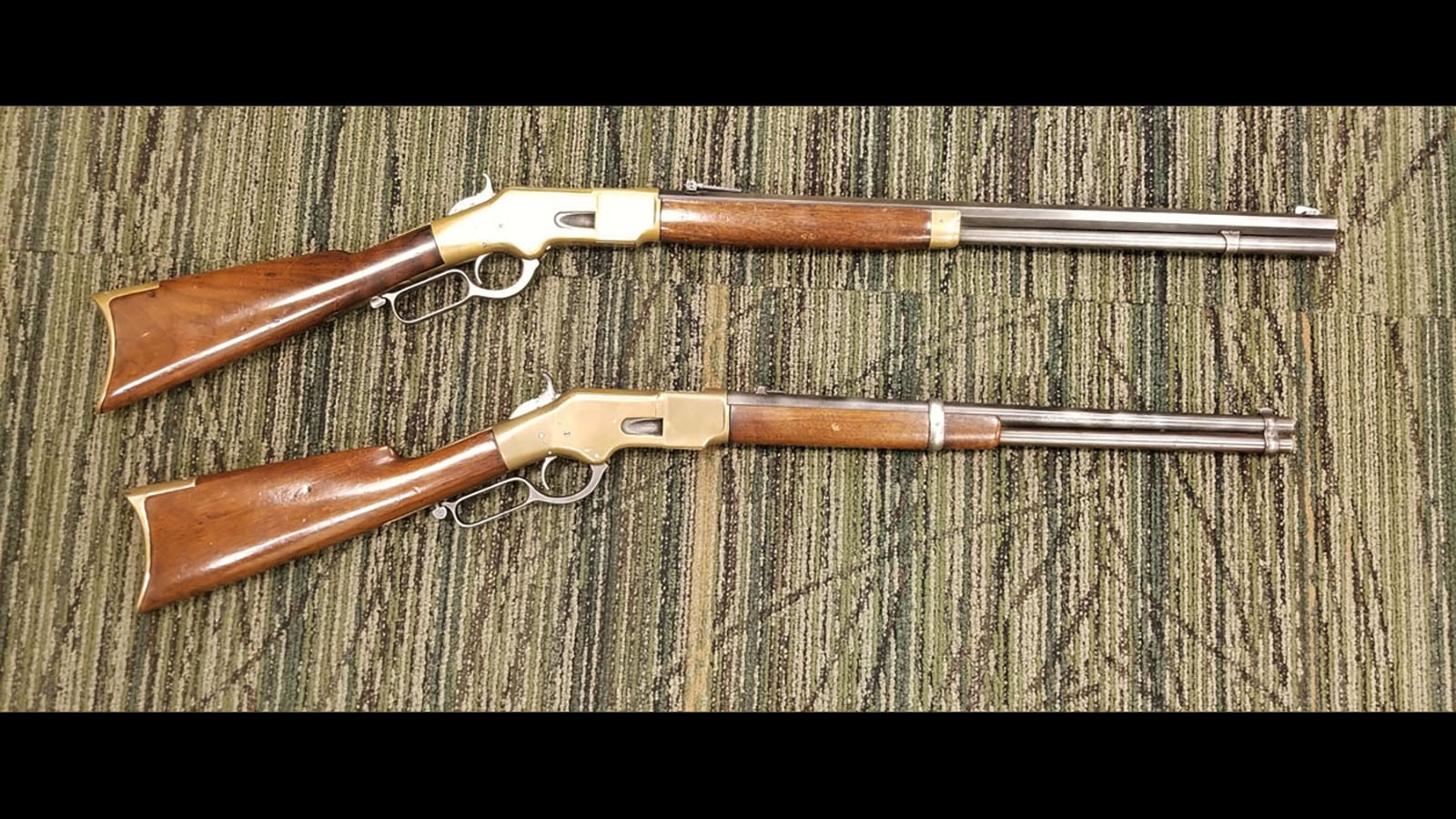GREEN RIVER — Like many in Wyoming, Dick Blust really loves guns.
But he’s not just a fan of fine firearms, he’s an expert — and for many who want to know more about vintage and obscure guns, he’s THE expert driving the Sweetwater County Historical Museum’s Vintage Firearms Research program.
Blust grew up in a rural town where guns were a daily part of life, competing in shooting tournaments. It was here his love for the shooting sports became a lifelong passion for firearms research, a skill that won him favor with a stern teacher in high school.
Blust said he was about 15 years old when he got in trouble for reading a book in class. It was unrelated to the lesson.
The teacher, seeing Blust not paying attention, asked, “You’re just gonna keep reading that, aren’t you?”
The teacher’s frustrated tone, as well as his reputation for being extremely strict, compelled Blust to put away the book.
But knowing his student was a gun enthusiast, that same teacher later shared his personal firearms collection with Blust, a moment that heavily influenced the boy’s future.
During their conversation, the teacher mentioned to Blust he was planning to sell one of his guns.
“He told me he was going to sell it for $100 and I told him, ‘I don’t think I would do that,” Blust told Cowboy State Daily “He asked why and I said, ‘Well, because I think it’s a rare gun and is worth more than that.’”
Taking his student’s advice, the teacher wrote a letter to the manufacturer to learn more about what he had. The response confirmed Blust’s intuition that the gun was, in fact, rare and was worth five times what he had considered selling it for.
“He never gave me any grief in his classroom after that either,” Blust said, chuckling at the memory.
A Born Detective
Blust is 70 now, about five years into retirement after a 30-year career in law enforcement. For much of that time he worked as a detective for the Sweetwater County Sheriff’s Office.
Throughout his life, Blust has continued to pursue his passion of researching firearms, and retirement was just the ticket to sharing that lifetime of knowledge.
He’s taken what had been a side hobby to a full-time position at the Sweetwater County Historical Museum. There, he created the Vintage Firearms Research Program, a free service offered by the museum to the public.
“Detective work was always fascinating,” he said. “I did a lot of research and investigation as a detective, and that’s a lot of what I do here too. In a sense, researching firearms is very similar. There’s an overlap between those two skills.”
Surrounded by books and technical data at the museum and equipped with the most recent technology, Blust spends much of his time researching antique firearms.
Each gun he studies is a portal to a different era, a tangible piece of history and story just waiting to be uncovered.

That Colt Second Dragoon
Blust has researched more than 200 firearms since being at the museum but of those, there are two that stand out to him.
One of these was an old cap-and-ball revolver that turned out to be a rare Colt Second Dragoon model owned by a local resident.
The Colt Dragoon first-, second- and third-model revolvers were produced between 1848 and 1861 and was used during the Civil War. It’s a .44-caliber revolver and a shorter cylinder with an improved loading lever and seven grooves with rectangular cylinder notches.
The gun Blust researched was one of only about 2,700 of Second Models made in the early 1850s.
He recognized the gun right away and went to work researching its history. He found the same model on an online auction that had a serial number within just a few numbers of the one he was researching.
“The gun at the auction was in slightly better condition than his and it sold for $25,000,” Blust said.
Then There Was The Luger
The second firearm that made an impression on Blust was a Military German Luger, also owned by a Sweetwater County resident.
This one had come home during World War II. It was in excellent condition, complete with its original holster and a disassembly tool for that specific gun.
“It turned out to be a rare police-issued Luger worth about $7,000,” Blust said.
And That Really Ugly Gun
From handguns to hunting rifles, Blust has seen a host of firearms throughout the years, but none more ugly than the Warner Infallible semi-automatic pistol.
He said its owner described it as “the ugliest gun ever made.”
One source described the gun as “the orphan child of self-loading pistols: awkward, ugly, repeatedly maligned, and reportedly dangerous to your health.”
The Warner Arms Co. of Norwich, Connecticut, made the gun from 1917-1919 in three variants. About 7,000 were made, all in .32-caliber automatic.
While named “Infallible,” the pistol was reported as anything but that, Blust said.
When the gun was incorrectly reassembled, only a small projection stopped the bolt from flying back into the shooter’s face when fired. Not surprisingly, it failed in the market with all production ceasing in 1919. The Warner Arms Co. went out of business shortly thereafter.
‘Incredibly Beautiful’ Winchester 1873
In all things there are opposites, and just as Blust considers the Infallible the ugliest gun, he believes a Model 1873 Winchester he once saw is the most beautiful gun he has ever seen.
“This gun was so incredibly beautiful I had to have an expert confirm it wasn’t refinished,” Blust said. “He took one look at it and said, ‘Nope that’s not refinished.’ It was so beautiful.”
The Model 1873 features a half-round half octagon barrel and half magazine.
Of all the guns Blust has researched, there is one he is a little more fond of — the lever-action Winchester rifle.
“They are the classic lever-action rifles of Western history and are in all the Old West movies. Winchester, ‘The gun that won the West,’ but you know the company didn’t adopt that motto until 1927, long after the frontier closed,” he said. “That motto was just a marketing tool.”
Despite the Winchester’s reputation, “There isn’t one gun that can be attributed to winning the West,” he said. “Guns were just so much a part of life then that you can’t point to just one gun.”
Shotguns A Challenge
In his years of research, the old single- and double-barreled shotguns have been the most challenging, only because many don’t have any identifiers on them.
“Companies in the East cranked out these cheap shotguns endlessly and there’s nothing unique about them, so there’s nothing I can tell you about many of these guns, Blust said. “There’s no markings on them, nothing. So, I don’t have any reference point to research them.
“But because there is so much reference information I can at least almost always come up with a basic outline or basic description of the gun.”
It Starts With Photos
Blust has earned a national reputation as a gun researcher and is sought after for his expertise. He begins a research project by either taking photos of the guns or by asking out-of-town owners to send their own photos.
“If there are markings on the guns or a serial number, especially a serial number, I want photos of those,” he said. “I really need photos of the entire gun because those markings and emblems and serial numbers help me find the history.”
The oldest gun he has ever researched was an 18th century Kentucky longrifle flintlock. The gun is considered a premiere classic firearm made in America and used by many frontiersmen like Davy Crockett and Daniel Boone. It was also used in the Revolutionary War.
“Firearms are such an extremely important part of Western history, American history and Sweetwater County history,” Blust said. “They are such an integral part of our history in this country.
“Americans have always loved their guns. Our entire history in this country would have been written differently without them.”
‘Cinderella Stories’
In most cases, antique gun owners are collectors who seek out and buy particular guns of their choice. Blust, however, has seen some who have accidentally ended up with a rare item worth a lot of money.
He calls these “Cinderella stories.”
One of these involved a Colt Single-Action Army Revolver. Owned by a man in the Midwest, he had no idea of the treasure he had bought. That is, until the manufacturer sent him a copy of the original letter Wild West legend Bat Masterson wrote to order the gun. That particular firearm sold in 2021 for just over $375,000.
“That’s a Cinderella story, and there are a few of those that do happen,” Blust said.
Beware Of Counterfiets
Buying a vintage firearm isn’t usually that simple. Blust warns collectors to be careful as it’s easy to be fooled by counterfeits.
A gun that has been known to be widely counterfeited is the popular and valuable 1897 pump-action shotgun. It is known as one of the most iconic pump actions ever built. Counterfeiters often alter a MOD 97 to pass it off as one of those trench guns.
“It’s not easy to counterfeit one of these guns, but it’s a lot easier than a lot of guns out there, and it happens regularly,” he said. “Just like counterfeit art, they will counterfeit a valuable gun.
“And if a person doesn’t know exactly what they’re doing or if they don’t find someone to examine the gun who knows exactly what they’re doing, it’s easy to get ripped off,” Blust added. “The more valuable a gun is, the more it’s going to be prone to counterfeiting.”
With more than 50 years of knowledge under his belt about vintage firearms, Blust remembers every gun he has researched and its details.
His passion for the work is as strong as ever. He loves all of it – the research, the history, the guns and the stories. Most of all, he enjoys seeing the excitement on the faces of people when he reveals what he learned about their guns.
“People get a big bang out of it when I am able to convey facts about their guns and the gun’s history,” Blust said. “They really get a kick out of it, and I’ll be honest, I get a kick out of it too when I’m able to provide the information to them.”












